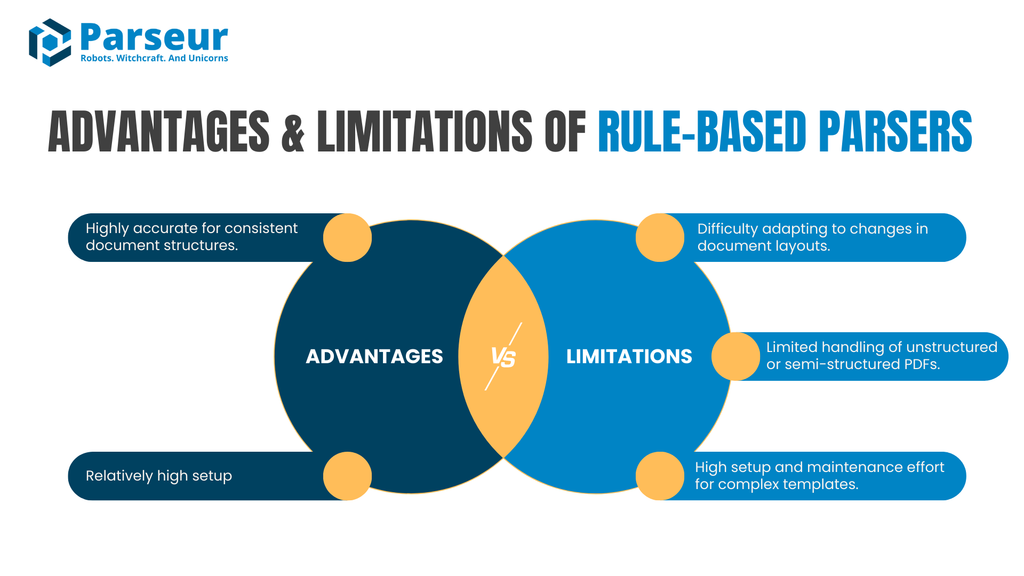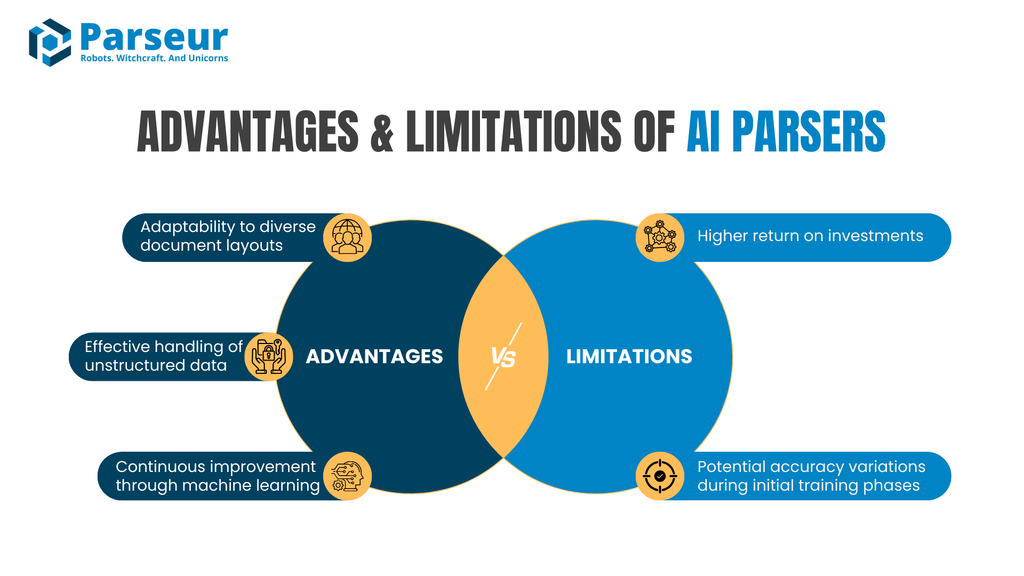Key Takeaways:
- Rule-based PDF parsers rely on predefined templates and are ideal for processing standardized documents like tax forms or system-generated notifications.
- AI-powered PDF parsers use machine learning and natural language processing to interpret unstructured data, making them more flexible for varied layouts and formats.
- Choosing between the two depends on your document type, complexity, and automation needs.
PDFs are part of any business operation, from invoices and contracts to reports and order forms. However, extracting data from them manually is time-consuming and prone to errors. Many businesses are adopting AI PDF parsers to simplify workflows and save time.
However, one question often creates confusion: Should you use a rule-based parser or an AI-powered one?
Both tools offer robust solutions but operate in very different ways. The rule-based PDF extractor follows strict instructions and is ideal for standard documents. On the other hand, AI-powered parsers learn from patterns, making them more flexible and better suited for complex or varied layouts.
We’ll break down the key differences between AI and rule-based parsing tools, highlight the pros and cons of each, and help you figure out which one fits your business needs best. Whether you're automating data entry for invoices, purchase orders, or any other document type, understanding these tools can make a difference in how efficiently your team works.
If you're new to PDF parsing or want a deeper dive into how it works, don’t miss our complete guide on What is a PDF Parser?, it’s the perfect starting point to understand the whole picture before choosing your parsing solution.
Understanding Rule-Based PDF Parsers
Rule-based PDF extractors are built on predefined rules or templates to extract specific data from documents. Unlike AI-driven parsers, which learn and adapt over time, rule-based parsers require a structured approach where you define the exact layout and content to extract. These parsers are best suited for documents with a consistent format, such as standardized forms, invoices, or contracts, where the data to be extracted remains in the same place across multiple documents.
However, rule-based parsing can become cumbersome when dealing with documents that frequently change structure. Even a slight alteration in the layout can break the extraction process, requiring manual adjustments to the rules or templates.
According to Gartner Research, poor data quality causes an average of $15 million yearly losses. Automating PDF data extraction can significantly reduce errors and improve data accuracy, making business reports more reliable.
Advantages & Limitations of Rule-Based Parsers
When considering PDF parsing solutions, rule-based parsers are often the first choice for businesses dealing with structured, repetitive documents. These parsers rely on predefined templates and rules to extract data, making them an efficient solution for standard document types.

Advantages of rule-based parsers
Rule-based parsers excel in environments with highly structured, repetitive document formats. These parsers are highly effective when the data to be extracted follows a predictable pattern, such as with invoices, purchase orders, and tax forms. They offer a few advantages:
- Highly accurate for consistent document structures: Rule-based parsers deliver high accuracy in extracting data from documents with fixed layouts, as the extraction rules are tailored to those layouts.
- Relatively faster setup for simple, repetitive documents: For straightforward documents like forms that follow a strict template, setting up a rule-based parser is quick and efficient, enabling faster processing of repetitive tasks.
For example, extracting basic fields like dates, product numbers, and total amounts from invoices is a typical application where rule-based parsing shines.
Limitations of rule-based parsers
While rule-based parsers offer great precision in controlled environments, they are not without their drawbacks:
- Difficulty adapting to changes in document layouts: If a document format changes, even slightly, the parser may fail to extract the correct data. This makes rule-based parsers less flexible when dealing with varied layouts or documents from different sources.
- Limited handling of unstructured or semi-structured PDFs: Rule-based systems struggle with unstructured or semi-structured documents, such as scanned images or handwritten notes, which lack a consistent template.
- High setup and maintenance effort for complex templates: Complex documents requiring numerous extraction rules can be time-consuming to configure and maintain, particularly if the layout changes.
Now that we’ve explored rule-based parsers, let’s see how AI-powered alternatives work.
Understanding AI-Powered PDF Parsers
AI-powered PDF parsers leverage advanced technologies such as Machine learning (ML), Natural language processing (NLP), and Large language model to process and extract data from documents. Unlike rule-based parsers, which rely on predefined rules, AI parsers "understand" the data, making them more adaptable to a broader range of document types and layouts.
How do AI-powered PDF parsers work?
AI parsers first train a model on a large dataset to recognize patterns and structures within documents. Once trained, they can automatically extract relevant information from complex, unstructured, or semi-structured documents.
Typical use cases
- Complex invoices: AI parsers can extract information such as dates, product names, quantities, and amounts, even from invoices with different layouts.
- Varied document layouts: Whether it’s a contract, financial report, or a government document, AI parsers are capable of processing diverse formats and adapting to changes in design.
- Handwritten text extraction: AI-powered OCR can also extract data from handwritten or scanned documents, which is beyond the capabilities of traditional rule-based parsers.
For businesses that deal with high volumes of varied or unstructured documents, AI-powered tools are an ideal solution to automate and enhance data extraction, saving time and reducing the potential for human error.
Advantages & Limitations of AI Parsers

AI parsing tools leverage advanced machine learning algorithms to adapt to document formats and layouts. This adaptability makes them ideal for extracting data from complex or unstructured documents.
Advantages
- Adaptability to diverse document layouts: AI parsers excel in handling various document formats and structures. Their machine learning algorithms enable them to process complex layouts, including tables, forms, and mixed-content documents, making them suitable for industries dealing with diverse paperwork.
- Effective handling of unstructured data: Unlike rule-based parsers, AI parsers can interpret unstructured data, such as free-form text, enabling information extraction from documents without predefined formats. This capability is particularly beneficial for processing contracts, reports, and other non-standardized documents.
- Continuous improvement through machine learning: AI parsers improve over time by learning from new data inputs. This constant learning process enhances accuracy and efficiency, allowing them to adapt to evolving document formats and extraction requirements.
Limitations
- Higher initial investment and complexity: Implementing AI-powered parsing solutions requires significant upfront investment in technology and resources. The complexity of setting up machine learning models and training them on relevant datasets can be resource-intensive.
- Potential accuracy variations during initial training phases: During the initial stages of deployment, AI parsers may exhibit fluctuating accuracy levels as the models adapt and learn from new data. Continuous monitoring and refinement are necessary to achieve optimal performance.
It's important to note that these limitations eventually fade away if you invest in an AI data extraction tool like Parseur.
Understanding these advantages and limitations is crucial for organizations to make informed decisions about adopting an AI-powered PDF reader that aligns with their specific document processing needs.
Rule-based vs AI-based parsers
When choosing the right data extractor for your business, understanding the core differences between AI-powered and rule-based solutions is essential.
| Criteria | Rule-Based PDF Parsers | AI-Powered PDF Parsers |
|---|---|---|
| How It Works | Uses fixed templates or manual rules to locate data fields | Uses machine learning and NLP to understand document layout |
| Best For | Standardized documents (e.g., invoices, forms, receipts) | Unstructured or varied layouts (e.g., contracts, reports) |
| Flexibility | Low: changes in format require new templates | High: can adapt to unseen formats with minimal input |
| Setup Time | Quick for structured documents, but requires manual configuration | Simple and easy set up |
| Accuracy | High for consistent formats; low for irregular documents | High, especially for messy, scanned, or complex layouts |
| Maintenance | High: templates must be updated with layout changes | Low: AI learns and improves with more data |
| Technical Skill Needed | Low to moderate | Low |
| Scalability | Limited to predefined layouts | Highly scalable for large and diverse document sets |
| Cost | Generally lower upfront cost | Low cost for users |
| Examples | Docparser | Parseur |
Conclusion
Choosing between rule-based and AI data extractors depends on your document types and business goals. Rule-based parsers are ideal for structured, repetitive documents where consistency is key. They’re quick to set up and highly accurate if your formats never change.
Conversely, AI-powered parsers shine when dealing with unstructured or complex layouts. Their adaptability and continuous learning capabilities make them a powerful tool for scaling document automation.
Before deciding, assess the variety and complexity of your documents. Consider how often your documents change, the level of accuracy you need, and the resources available for setup and maintenance.
Frequently Asked Questions
When choosing between a rule-based and an AI parser, many users have questions, and some persistent myths can make the decision even more confusing. Let's take a moment to clear up some of the most common misconceptions and frequently asked questions:
-
What is an AI parser?
-
An AI parser is a tool that uses artificial intelligence to recognize, interpret, and extract data from documents, even when formats vary or fields are not clearly labeled.
-
What is the difference between rule-based and AI parsing?
-
Rule-based parsers use predefined templates and logic to extract data, which is ideal for standardized documents. AI parsers use machine learning and natural language processing to handle varied, unstructured formats.
-
Is AI parsing always better than rule-based parsing?
-
Not necessarily. AI shines with complex or varied layouts, but rule-based methods are often faster and more accurate when the document structure is predictable.
-
Do AI PDF parsers require technical expertise to set up?
-
Many modern AI tools are designed for non-technical users, offering user-friendly interfaces and minimal setup. However, some advanced tuning may still require technical input.
-
Can I use both AI and rule-based parsing methods together?
-
Yes, hybrid approaches are increasingly common. Many platforms allow combining both methods to optimize accuracy and flexibility, depending on the document type.
-
What is hybrid PDF parsing?
-
A combination of AI and rule-based approaches to optimize accuracy, speed, and flexibility for varied document types.
-
Can AI parsers handle scanned documents and handwriting?
-
Yes. Advanced AI-powered OCR can extract data from scans and even handwritten text with increasing accuracy.
Last updated on




